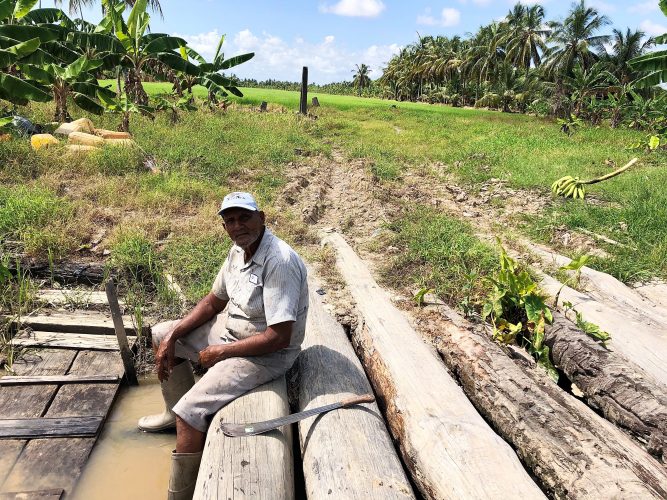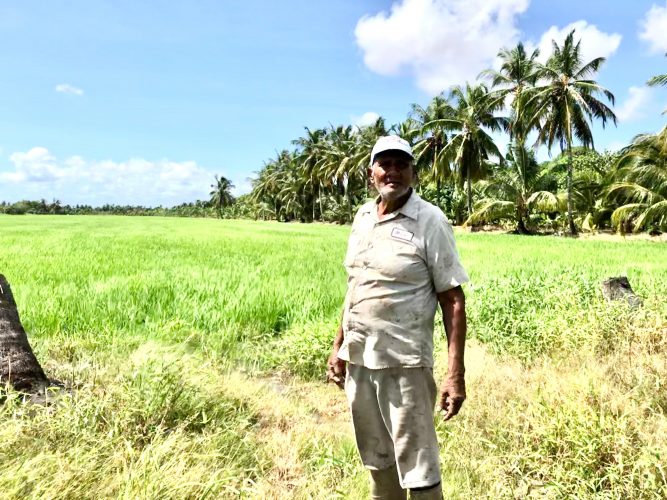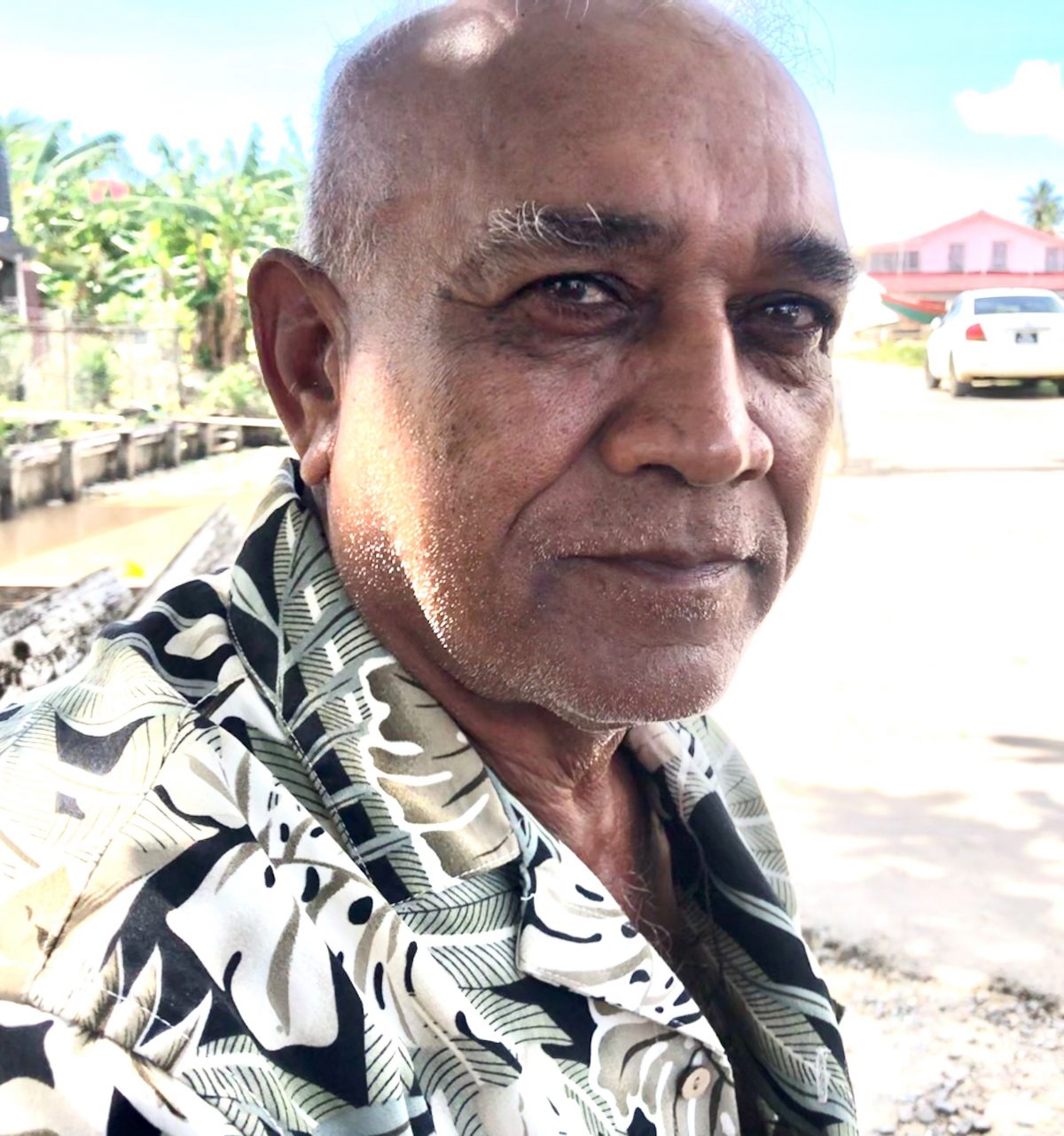Despite bumper production countrywide last year, rice farmers in Wakenaam say that the industry is not profitable anymore due to the rising production cost but are hopeful that it would be revived when Guyana starts to benefit from oil revenues.
Last year’s countrywide production is the second highest on record, with 1,049,874 metric tonnes of paddy produced.
During a recent visit to the Essequibo River island, some of the small farmers told Stabroek News that despite the hard work and the investment they put into the crop, they are still struggling.

According to one farmer, “It is very frustrating at the end of the crop when we barely make enough money for food and to invest back in the crop.”
He said too: “We do all the hard work, from very early in the mornings to late at nights sometimes but the sad part is that we are not the ones to reap the benefits.”
The farmer, who did not wish to be named, said too: “A few years ago I was able to save money from my

income. But now the times get so hard that instead of adding to my savings, I have to take out from it… I’m just praying for things to get better in this country.”
He is confident there would be progress with the rice industry “when the oil money starts to flow because we would pay less to produce the rice.”
He noted though that “it can only happen if we have better management.”
Another farmer, Hardat Persaud, who has been in the rice business from a young age with his father said he is paying $1,000 for a gallon of fuel, $5,500 for a bag of urea fertilizer and $6,500 for a bag of triple fertilizer. Added to that, he has to pay a labourer $1,000 per bag to sow the paddy.
One bag of each type of fertilizer is used on one acre of rice.
“What I must say? The rice industry is not profitable anymore. But we have to do it because there is nothing more we can do,” Persaud lamented.
“That’s what the people of this island have to do. We plant a little rice or we plant a little farm, we mind a couple a cattle and if you have a good cast net you catch lil fish and shrimp and you make yuh roti (for dinner) and you’re alright there.”
He argued too that the “millers are robbing the farmers, with the grade and the weight.”
According to him, a miller made the farmers fill one bag with 200 pounds of paddy. This amounts to one and a half bags of paddy but they were only paid for one bag. The normal weight for a bag of paddy, he said, is 150 pounds.
Presently they are selling their paddy to a miller on the Essequibo Coast and have to pay to transport it there.
“At one time the guy who was buying the paddy was deducting $500 per bag (for transportation. When we calculate our expenses, like for ploughing and the price for fertilizer and harvesting half of the money finish…”
The last price they received for paddy was $2,500 and for the previous crop they were paid $2,900.
He told Stabroek News that he owns a combine and a tractor to ply his trade but the “spare parts are very expensive.”
He said too, “You see, during the previous administration, we got duty-free concession every three years to purchase a tractor. But they (present government) cut off all those things. Now the people who making the money are the people who selling the parts… But despite the price, you have to buy it…” Persaud said.
He added: “Life is not too easy; it’s a bit rough. But you have to try and make ends meet. Some people have children going to school and they have to get good bicycles for them. Transportation is not (easily) available here…”
According to him, when his children were at school, he used to wake up early in the mornings and pump the bicycle wheels before going to the backdam to start the day’s work.
He did not want them to have a puncture along the way “because the road is very lonely.”
He said this government promised to give the rice farmers concession for fuel “but we never get it, the gold miners and thing get it…”
There are a “couple hundred rice farmers on the island,” with the largest planting about 200 acres of rice.
In terms of drainage and irrigation, he said it was “reasonable in this island. The government has an excavator and they doing a good job cleaning the trenches and so on… We can’t complain about that because the council supplied boards to make the koker doors. In that way it helped the farmers. They used two-inch thick greenheart boards.”
Taking a rest
Stabroek News caught up with Seetal Jewnandan, 72, as he was taking a rest on a bridge in front of his rice field. His feet were hanging over the trench.
He had been in the rice business with his father from a young age but migrated to Venezuela several years ago.
He did construction and other work for a huge oil company and soon had a successful life there with his family.
But two years ago when the country faced economic crisis, he was among many Guyanese to return and start a new life here.
Luckily his elder brother offered him his rice land so he could cultivate and earn and income. The field is located at Friendship, close to his home.
Jewnandan also takes care of his brother, who is not in the best of health.
He had already gotten the rice farming skills from his father from a young age.
He described Venezuela as a beautiful place and said that in some areas they did not “have to pay rates, electricity and water bills.”
He said too: “Life got hard, money was not circulating and government could not supply everybody with food.”
Apart from rice, he is also engaged in banana and coconut farming on the land at the edges of the field.
Even though he was excited to get back into farming, he said “it is not working out good.”
He too said the cost of production is very high and the price that they are being paid for the paddy cannot compensate for their expenses.
“You have to pay for the combine and the truck to carry the paddy across to Essequibo on the pontoon. I ain’t paying cash but when we receive the money (from the millers), I pay…”
He said too that the millers fix the price for the paddy and that “whatsoever they (millers) give you, you have to take…”
He said too that other expenses incurred, such as for fertilizers, insecticide and labour, also add up to a lot.
“When you really work off the thing is just a margin yuh getting,” he told Stabroek News. “If you really want to make something you have to do most of the work yourself.”
He recalled too that when he was planting rice under the presidency of the late Cheddi Jagan, “the government was subsidizing the rice farmers… they used to give cut price on things like fertilizer and insecticide.”
He said too that at that time the island had a silo and “we did not have to pay freight to carry the paddy nowhere… But now it scrap. But nevertheless, we deh here struggling.”
He also does plantain farming and would wholesale the produce to the middlemen who would in turn take it to the markets at Parika and other places.
He said the plantain farming would be feasible when “when they pay us a good price… but the price varies.”
It also depends on the quality of plantain that they reap, noting that sometimes the crop would “get disease.”
He said there are two types of diseases and that “right now the red leaf disease is affecting my crop.”
Even his coconut trees need spraying for worms but he was not able to purchase the drug on the island.
He is expecting to harvest his rice crop in March and is praying that it will be a successful one.
Stopped planting rice
Doodnauth Persaud of Maria’s Pleasure said he stopped planting rice because of the production cost.
It had also cost him a lot to hire machinery for cultivating and harvesting while he also spent $15,000 to $18,000 per acre to rent the rice land.
He decided to quit after he could no longer afford to invest.
He said that for the past few years he started “running at a loss. Right now I am still paying rice debts, for some fertilizer I bought from a man.”
Doodnauth recalled that the last price he received for paddy was $1,500 per bag. With the previous government, he said, he enjoyed a price of 3,500 per bag. He said the price dropped after the Venezuelan market collapsed.
According to him, the APNU+AFC government “promised to pay us $9,000 per bag for paddy.”
He said too that they had hopes then that things would get better, but instead, they are very disappointed in the state of the industry now.
Right now he’s doing plantain farming. He wholesales his produce to hucksters on the island who would sell to vendors at the Parika market.
The plantain business, he said, is good at times and he is able to make ends meet.
But like the other farmers, he cannot wait for the rice industry to start thriving again.





